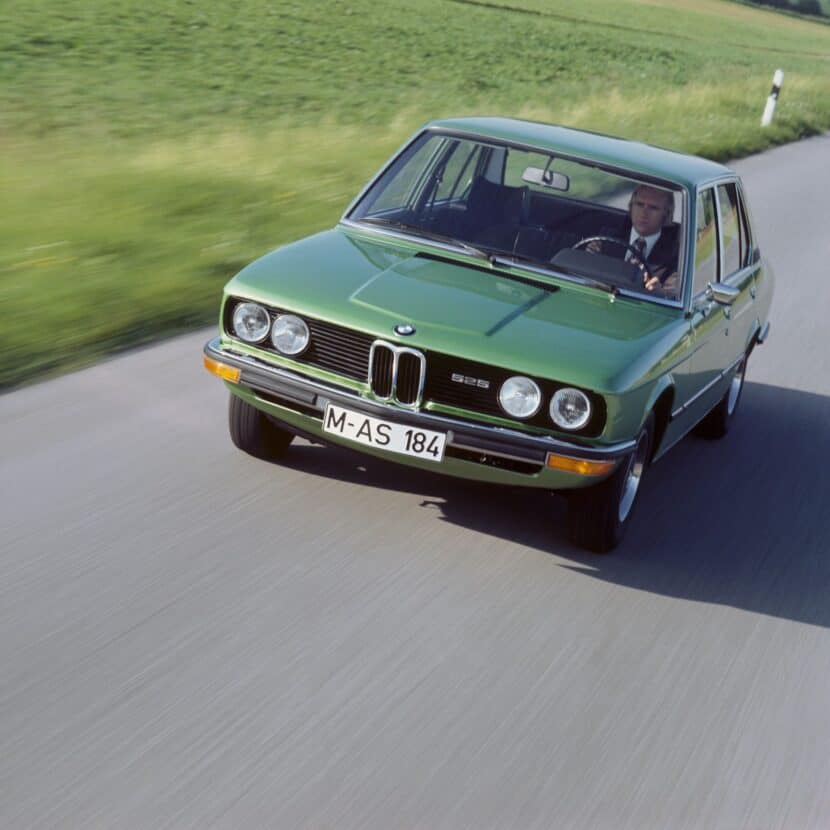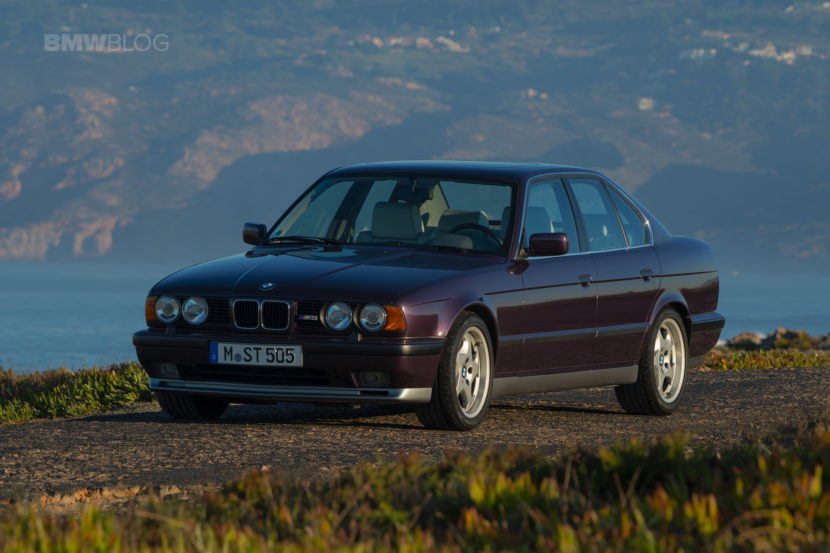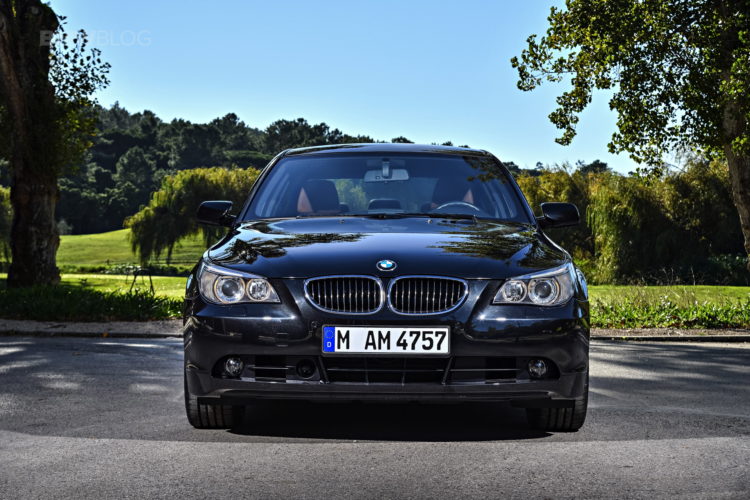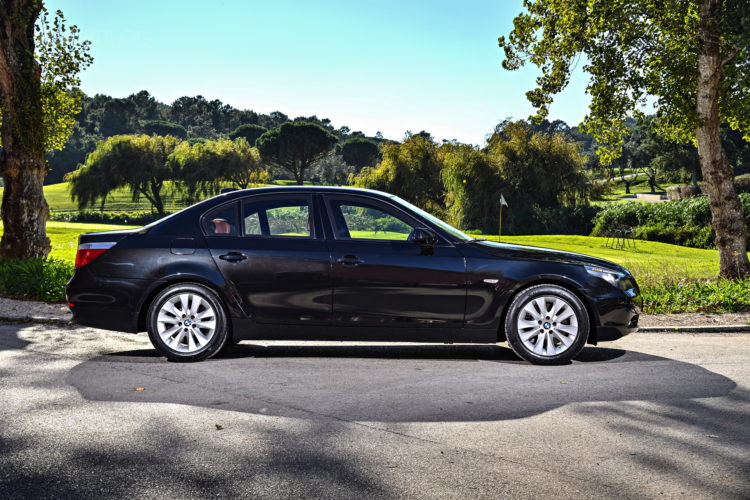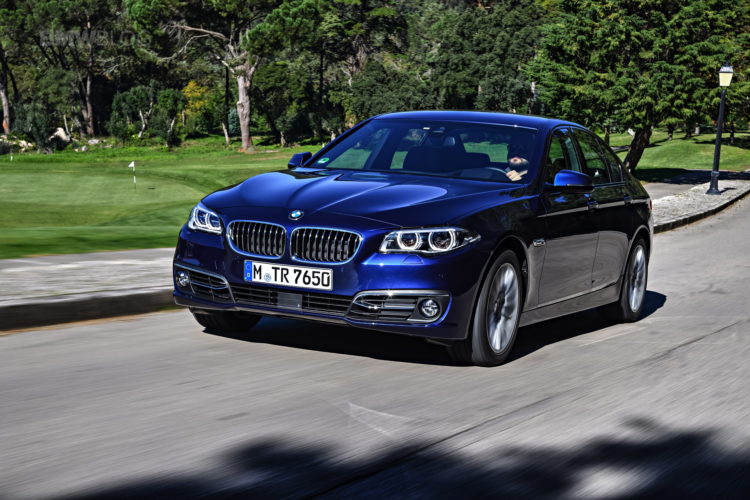The BMW 5 Series debuted in 1972 and has been a mainstay of the brand ever since. But BMW has made plenty of changes through the car’s eight generations. As a result, the BMW 5 Series ownership experience — and driving experience — varies wildly. Of course, that’s usual for the rare nameplate with 50 years of heritage behind it. Whether you’re drawn to the older models for their iconic styling and unparalleled steering or dodging depreciation by buying a few years away from brand-new, each 5 Series generation has something to look out for when it comes to common issues and reliability.
First Generation BMW 5 Series (E12)
The first generation 5 Series debuted in 1972, and even the newest E12 is nearly forty-five years old. Production ran until 1981, but contrary to our usual advice, we’d say the older the better. Assuming you aren’t importing a version from another country — although you might — US versions were limited to 1975 model years and up. The good news there is that the 530i came with a 3.0-liter M30 inline-six. Even early M30s are fairly stout but do have occasional issues concerning oil and water pumps. Regular valve adjustments should be a priority, as should cooling system checkups (and a coolant flush every few years). Finally, there was a class-action lawsuit for the exhaust gas recirculation system (EGR), though by now I imagine those have been replaced on effected cars.
By 1979 the 530i became the 528i, and power went down. The 2.8-liter version of the M30 isn’t largely different from the 3.0-liter engine, but does feature more emissions controls like a catalytic converter and oxygen sensor. These added complexities are just more things to break. That said, the five-speed BMW added in 1980 is a nice bit of kit. And, it should be noted that the M30 is hardly unreliable.
Looking outside of the US market, the holy grail of the lineup is obviously the vaunted M535i, predecessor to the M5 and powered by an M1-derived M30B35 engine. These are now extremely high-dollar cars, and we recommend simply getting a pre-purchase inspection before touching one. Closer to most shoppers’ budgets are M10- and M20-powered cars; the latter an inline-six and the former a straight four.
The M20 is a great option because, like the M30, it remained in production until the mid/late 1990s. So, plentiful parts and lots of information. The M20 notably uses a timing belt, as well. Aside from its astonishingly low power (under 100 horsepower in some cases) the M10 is also fairly reliable, sans valve guide and camshaft wear from poor maintenance habits. Regardless, the age of these cars practically guarantees plenty of unknowns that will vary from example to example. There are safer reliability bets to be made in the BMW 5 Series lineup. Even if you’re looking vintage.
Second Generation BMW 5 Series (E28)
BMW produced the E28 5 Series from 1981 until 1988, stuffing four- and six-cylinder engines under the hood. But the first model to come to the US was the 528e in 1982, which utilizes a 2.7-liter M20 engine. The M20 is a great engine with lots of parts around (in remained in production until the 1990s). You can also step out of the “28” and Eta league with the 533i, which uses the M30 inline-six. It’s as stalwart here as it is in any other application. You can also find the M30 under the hood of the 535i and M535i. We wouldn’t recommend picking up the oddball 524td (diesel) variant, but they aren’t too bad to maintain either.
The E28 generation also introduced the first M5. The M88/3 is an even more directly related to the M1 than the preceding generation’s M535i. Like with the previous generation, these cars have become extremely high-dollar so we recommend getting a good pre-purchase inspection before pulling the trigger. The US-spec S38 engine is an early iteration displacing 3.5 liters that offers great power but can require attention (and cash) if not properly maintained. Regardless of powertrain, the E28 is fairly susceptible to rust, particularly around the front fenders, license plate lights, and trunk. Dashboards will crack, too, and make sure to play with all the electronics. Radios, gauge clusters, and (of course) window regulators are all occasional trouble spots.
Third Generation BMW 5 Series (E34)
The third generation BMW E34 5 Series ran from 1988 until 1996. As a result, there are a handful of new technologies that can make these cars both better to drive and more complicated. With nearly a dozen different engines, there’s a lot to cover, too. The M20 returns under the hood of early 520i and 525i models. The M30, too, comes back, in the pre-1991 530i and all 535i/535is models. As mentioned elsewhere, these stout and very popular engines are great, requiring little more past regular maintenance. New to the E34 is the M50 engine. The M50 succeeds the M20, using a timing chain rather than belt.
Notably, M50 engines produced after 1992 will also have VANOS, adding complexity. A pre-1992 M50 is preferable to either an M20 or post-92 strictly in terms of reliability. You can find them in the 525i and 520i/520is, which after 1992 use a TU version that gets VANOS. The 524td exists, but you’d be better served by the 525td which replaces it. The new M51 engine makes better power and is hardly any less reliable than the motor it replaces. European markets saw the introduction of new four-cylinder engines, the M40 and later M43. The M43 is the superior version, gaining a timing chain, new roller rockers for the valve train, and more power.
Finally: the E34 generation also introduced the V8 engine to the BMW 5 Series. The early M60 V8 used Nikasil coatings, which by now are either replaced or are not going to present issues. M60s also are vulnerable to timing chain guide failure and cooling system issues. The E34 M5 uses a new S38, bored to 3.8 liters, and is still generally accepted to be fairly reliable. The E34, otherwise, isn’t much different than looking for an E28. Like the E28 and any other 30+ year-old car, rust, worn suspension components, and faded/cracked trim pieces will be common issues, and checking the electronics before you buy is a good idea.
Fourth Generation BMW 5 Series (E39)
BMW brought the E39 5 Series to market in 1995 internationally, but here in the States you’ll only find them post-1997. The E39 BMW 5 Series was manufactured until 2004 and is a huge fan favorite for its classy looks, good power, and engaging steering. Another excellent point for the E39 BMW 5 Series is that only inline-six and V8 engines were under the hood. Particularly the delightful M52 and M54 inline-six engines (early models used the M52). Both engines are mechanically similar and plagued by relatively small, but persistent issues that include the cooling system, DISA valve, and oil filter housing gasket. VANOS reappears here, inherited from the M50, and can be a potential pain point.
V8 engines are present on the 535i, 540i, and M5 models. The M62 V8 is much improved from the M60, but it’s still a tough sell from a reliability standpoint. VANOS issues are more widespread here than in the six-cylinder non-M variants, cooling system issues persist, timing chain guides are a real problem, and it’s bound to leave a bit of oil everywhere it goes. The S62 in the M5, while glorious, will also require an open checkbook, exhibiting almost all of the same problems as the M62 with the added annoyance of rod bearing failure. An ounce of prevention is worth a pound of cure, which is precisely why well-maintained V8 E39s will fetch quite a premium.
The E39 BMW 5 Series is an excellent driver’s car, but it’s definitely not the most reliable way to get into a 5 Series. Late 1990s BMW problems persist here — although, the good news is that quality starts taking an uptick after this point. So, window regulators and dead pixels in the dash simply come with the territory. Other E39 issues include interior and exterior trim cracking, trunk wiring fraying, and surprise amber warnings in the dash (ABS/DSC/BRAKE) because of faulty sensors. The very nice thing about the E39 is that it still has a tremendous community — you can check out the very best links here.
Fifth Generation BMW 5 Series (E60)
The E60 5 Series’ biggest claim to fame is the V10 powering the M5 of its day; and we’ll start there. This is one of those cars where if you have to ask, it’s probably a bad idea. While not inherently unreliable, expenses mount quickly, and the S85 engine has no shortage of common failure points. High oil consumption, rod bearing wear, VANOS failure, and throttle actuator failure are high-dollar and high-frequency problems. Window regulators, idle valve actuator, and little (but important) things like oil coolers can quickly inhale much of your maintenance budget, too. The S85 is hands-down my favorite BMW engine…in theory. A pre-purchase inspection (and pre-purchase oil analysis, if possible) is worth its weight in gold here.
In the US, the E60 also came exclusively with eight- and six-cylinder engines, like its predecessor. The M54 sits under the hood of early, non-turbo models. It’s a good, solid engine with relatively few major problems. Expect cooling system, DISA valve, and oil filter housing gasket issues. The M54 is later replaced by the N52, which is arguably one of the best and most underrated engines BMW ever made. Issues are few, and mirror what you expect from an M54 engine. The hotter 535i got the N54 engine, which tends to lean back onto the unreliable side of things. Expect woes surrounding the fuel pumps, water pump and cooling systems, injectors, spark plugs/coil packs, charge pipes, and turbo wastegates. Gaskets, too, seem to wear out quick on these cars, primarily valve cover gaskets and oil filter housing gaskets.
The N62 engine also makes an appearance in the 545i and 550i models. While not all turbo V8s from BMW are bad investments, the N62 is nothing short of a money pit, generally speaking. Smaller issues are coolant leaks, SAIS (secondary air injection system) failure, coolant Y-pipe failure, and alternator brackets. Bigger problems like valve stem seal and valve cover gasket failure are also frequent. Then there’s Valvetronic motor oil leaks and oil pump check valve failure to think about. While arguably the E60 is a step up in terms of interior quality from the E39, it takes several steps backwards when considering long-term ownership. Unless, of course, you’re prepared. We won’t argue — the V8 and V10 engines deliver prodigious power and are, to some, worth the effort and cash. For what it’s worth, there’s an entire PDF surrounding E60 ownership that circulates the web and every prospective/current owner should read. I’m happy to provide it if you get in touch. No other 5 Series chassis has that, for better or for worse.
Sixth Generation BMW 5 Series (F10)
The F10 BMW 5 Series debuted in 2010 and brought new, turbocharged engines along with an old favorite. The N52 inline-six appears here in non-turbo models; that is, the 528i in the US. Elsewhere you’ll find the N55 inline-six in the 535i models, which is a slightly improved-upon version of the N54 in the E60. From 2012 on the 528i utilizes the N20B20 turbocharged four-cylinder, which is sadly notorious for timing chain failures. A recall exists for pre-2015 models, so make sure that’s taken care of. Otherwise it isn’t too bad of a mill. Quality, overall, of the F10 BMW 5 Series is good; you might encounter armrest wear or beat-up buttons that get touched frequently (steering wheel/climate control, etc), but other than that, the F10 is mostly standing up to the test of time.
By the F10, getting V8 power in a 5 Series is finally at the point where it can be had without a second mortgage for maintenance needs. The N63 engine appears at the top of the non-M lineup, the 550i. From 2014 on, the 550i got the updated “N63TU” engine, a vastly improved 4.4-liter from both the N62 units and the earlier N63 (which was arguably even worse than the N62). Shockingly, the best V8 here is the one under the hood of the full-blown M5. Despite some usual BMW woes — VANOS, cooling, rod bearings, and timing chain guides — the powerplant is still overall less troublesome than the N-code V8 engines in this application.
Seventh Generation BMW 5 Series (G30 and F90)
It’s still a little early to assess long-term reliability on the seventh and eighth gen cars, but we have a good idea who the standouts of the generation are. The G30 5 Series utilizes only turbocharged engines; the meat and potatoes of which are B48 inline-fours and B58 inline-sixes. Both are good engines with relatively few persistent problems. Gaskets (oil filter housing and valve cover) are semi-regular on the B58; coolant and oil leaks and charge pipe failure are occasional B48 woes. The biggest unknowns of the G30 BMW 5 Series are the 530e iPerformance and 545e hybrid models; we would steer clear unless you really, absolutely need a hybrid. (Hint: you probably don’t.)
At the higher end lurks the V8-powered M550i xDrive and the almighty F90 M5. All versions of the M550i xDrive are fairly reliable by now, because they all use at least a twice-updated N63TU engine. 2020 model year and newer cars will be the most reliable, featuring even more mechanical changes that will likely see these cars running even a decade from this writing with little more than regular maintenance. The F90 M5 uses a newly-updated S63, the S63B44T4. So far, the outlook is pretty good on this engine: just remember to budget appropriately for maintenance.
Eighth Generation BMW 5 Series (G60 and G90)
As with the G30, the eighth generation of the BMW 5 Series G60 is still a little bit too new to accurately judge long-term reliability. Right now, we expect the B58-powered models (540i xDrive) to last the longest, but we’re sure the four-cylinder models won’t be slouches, either. The G90 M5 and G99 M5 Touring now rely on a hybrid system, which may have severe impacts on resale and reliability in the coming five or six years. Unfortunately, all we can really do is wait and see.
Conclusion: BMW 5 Series Models, Ranked By Reliability
While some of my favorite BMW models appear on this list, evaluating each solely on the metric of general reliability is quite a different feat than simply rating my favorites. In order of reliability, we’d rate the E28 5 Series as the most reliable overall. On the least reliable side, we’d put the E60. A complete list would look something like this:
- E28
- G30 and F90 (G60 and G90, too…for now)
- E12
- F10
- E34
- E39
- E60
Of course, there are caveats here, too. An N52-powered E60, for example, is likely to be a lot more reliable long-term than, say, a V8-powered E34. It’s important — especially as these cars age — to evaluate each car on an individual basis. Unfortunately, service history can wildly vary from one car to the next. And that has a commensurate result on how “reliable” your new 5 Series might be. Good luck out there — you may need it.
Frequently Asked Questions About BMW 5 Series Reliability
Which BMW 5 Series generation is the most reliable?
The E28 generation (1981–1988) is widely considered the most reliable, thanks to its simpler mechanical components, durable inline-six engines, and minimal electronics.
Are BMW V8 engines reliable?
Some are, but many V8s in the 5 Series—like the N62 and early N63—are known for high maintenance costs and complex issues. Later versions like the N63TU (post-2014) are significantly improved.
Is the E60 BMW 5 Series a good used car?
It depends on the engine. N52-powered models are solid, but V8 and V10 variants (especially with the S85 engine) can be expensive to maintain and prone to issues without extensive upkeep.
What is the best used BMW 5 Series for daily driving?
The F10 generation (2010–2017) offers a good balance of reliability, comfort, and modern tech. Models with the N52 or updated N63TU engines are preferable for long-term ownership.
Should I buy a hybrid 5 Series like the 530e or 550e?
Hybrids like the 530e can be useful for short commutes, but long-term reliability is still uncertain. Battery degradation and higher repair costs may become concerns as they age.


